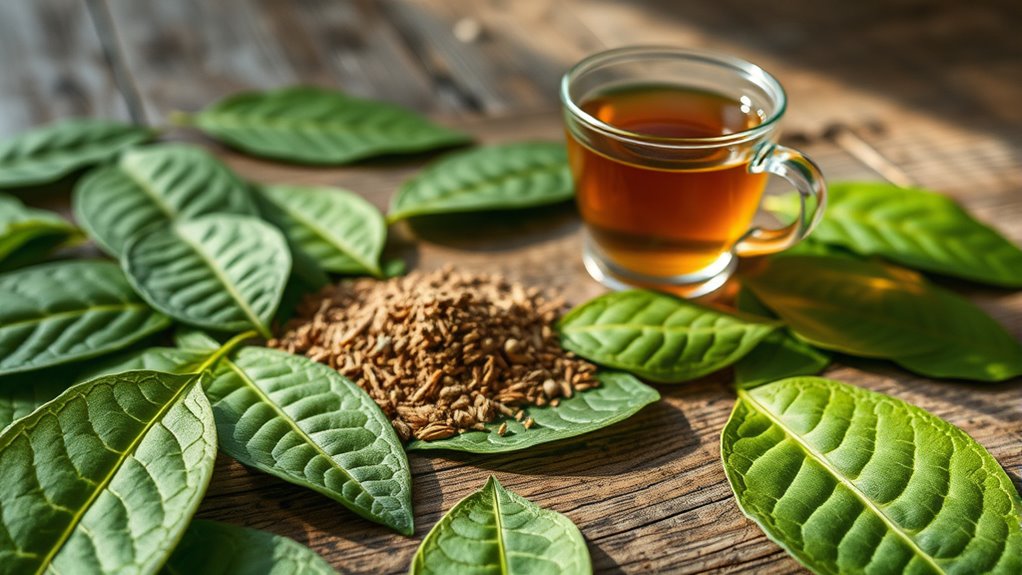Kratom may seem like an all-natural way to relieve pain or replace opioids, but it carries serious risks. It interacts with your brain’s opioid receptors, which can lead to dependence, addiction, and side effects like nausea and dizziness. Since quality varies and safety isn’t guaranteed, self-medicating can be dangerous. It’s important to understand that natural doesn’t always mean safe—more details can help you make informed choices.
Key Takeaways
- Kratom acts on opioid receptors, providing pain relief but carries risks of dependence and addiction.
- Marketed as a natural supplement, but its safety depends on quality, dosage, and individual health factors.
- Lack of regulation leads to variable potency and potential adverse effects like nausea, liver issues, and respiratory problems.
- “Natural” does not guarantee safety; long-term use may result in physical dependence similar to opioids.
- Consulting healthcare professionals before use is essential to avoid dangerous interactions and improper self-medication.

Kratom has gained popularity as a natural remedy for pain relief, but its safety remains a hotly debated topic. Many people turn to it as an alternative to traditional medications, hoping to find relief without the risks associated with prescription drugs. One reason for its appeal is its use as an opioid substitution. Some individuals struggling with opioid dependence or addiction see kratom as a way to manage withdrawal symptoms or reduce cravings. Unlike opioids, which are tightly controlled and have a high potential for abuse, kratom is often marketed as an herbal supplement, making it more accessible and seemingly safer. This perception encourages many to self-medicate, believing they’re making a natural choice to improve their health.
However, this perception can be misleading. While kratom is classified as an herbal supplement in many countries, it doesn’t mean it’s free from risks. It contains alkaloids that interact with the same brain receptors as opioids, which can lead to dependence or addiction if used improperly. Because it’s often purchased online or from unregulated sources, the quality and potency of kratom products vary widely. This inconsistency increases the chances of adverse effects, such as nausea, constipation, dizziness, or even more severe health problems, including liver damage or respiratory issues. When you rely on kratom as an opioid substitute, you might think you’re avoiding the dangers of prescription painkillers, but in reality, you could be exposing yourself to new health risks.
Many users see kratom as a natural alternative that helps them manage pain and mood without the harsh side effects of pharmaceuticals. That’s part of why it’s become popular as an herbal supplement. Yet, the line between natural and safe isn’t always clear. The lack of regulation means you’re often left to determine dosage and quality on your own, which can lead to accidental overdoses or dangerous interactions with other medications. Additionally, because kratom acts on opioid receptors, long-term use can lead to physical dependence, just like traditional opioids. If you’re considering kratom for pain relief or as a way to substitute opioids, it’s essential to understand that “natural” doesn’t always equate to “safe.” Consulting with a healthcare professional and exercising caution can help you avoid the potential pitfalls of self-medicating with this controversial herbal supplement. Moreover, understanding the diverse designs and materials of various herbal products can help consumers make safer choices.
Frequently Asked Questions
Is Kratom Legal in All Countries Worldwide?
You might wonder if kratom is legal everywhere, but its legal status varies worldwide. Some countries regulate or ban it due to safety concerns, while others permit its use. International regulation is inconsistent, so you should check local laws before considering kratom. You can’t assume it’s legal everywhere; always research current laws in your country or region to avoid legal issues.
What Are the Long-Term Health Effects of Kratom Use?
Did you know that about 20% of kratom users report dependency potential? Long-term use can lead to chronic health risks, including liver damage and gastrointestinal issues. You might also develop tolerance, increasing your dosage and risking addiction. While some use it for pain relief, understanding these risks helps you weigh the potential benefits against long-term health effects, making informed choices about your well-being.
Can Kratom Be Safely Combined With Other Medications?
You should be cautious about combining kratom with other medications, as drug interactions can lead to serious side effects or reduce effectiveness. It’s essential to consult your healthcare provider before mixing kratom with any drugs. Always follow safety precautions, such as starting with low doses and monitoring your reactions closely. Never assume it’s safe to combine kratom; professional guidance helps prevent potential health risks and guarantees your safety.
How Does Kratom Interact With Alcohol or Recreational Drugs?
You might think mixing kratom with alcohol or recreational drugs is harmless fun, but it’s like playing with fire in a fireworks factory! These combinations can dangerously amplify drug interactions, risking severe side effects or overdose. Safety concerns skyrocket when you combine substances, as the effects become unpredictable and potentially deadly. Don’t underestimate these risks—staying informed and avoiding risky mixes keeps you safe and in control.
Are There Any Approved Medical Uses for Kratom by Health Authorities?
Currently, you won’t find kratom approved by major health authorities for medical use. Medical research hasn’t established clear benefits, and its regulatory status remains uncertain. Authorities like the FDA warn against using kratom for treatment due to safety concerns and lack of proven efficacy. If you’re considering kratom, you’ll need to carefully weigh the limited scientific support against potential risks, as it isn’t officially recognized as a legitimate medical remedy.
Conclusion
Ultimately, kratom is like a double-edged sword—promising relief but hiding potential dangers. You stand at a crossroads, deciding whether to walk the path of natural remedy or risk falling into a pit of self-medication. Like a delicate dance, using kratom requires balance and caution. Remember, what seems like a gentle breeze could quickly turn into a storm. Stay informed, tread carefully, and always listen to your body’s silent warnings.










